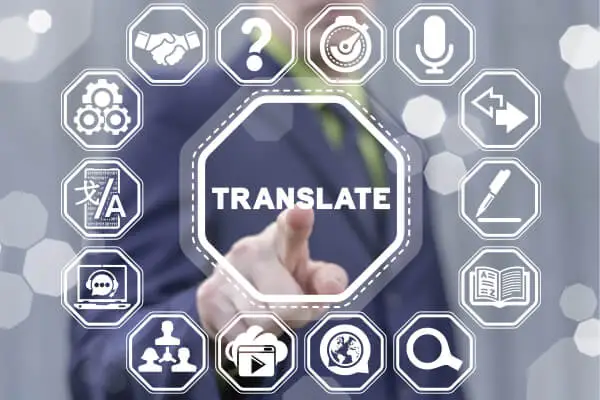

Machine Translation Services
Machine translation (MT) involves the use of computers and software programs to generate translated output. This technology has evolved to a point where, under the right conditions, it can be a valuable asset and a powerful tool.

Machine Translation Services
Machine translation (MT) involves the use of computers and software programs to generate translated output. This technology has evolved to a point where, under the right conditions, it can be a valuable asset and a powerful tool.
Machine Translation Related Content
Machine Translation Services
Trusted Translations has specialized teams dedicated to implementing different types of machine translation solutions. Our teams are on the cutting edge of new technology and understand exactly how to integrate MT solutions with other translation tools as well as humans, combining these in just the right way to take advantage of the speed, security and accuracy of the machine with human expertise in post-editing and reviewing. By thoroughly understanding the benefits and limitations of the latest MT technology, we can determine how MT can be effectively used in almost any translation scenario. Our experts act as consultants to evaluate whether an MT solution is right for a particular client, domain and project scope. After a few sample-testing steps, and once both the client and our experts have determined the right MT solution and architecture, our teams will start working to implement the right workflow and technology. This initial effort is well worth the investment, for it will ensure an excellent ROI for our clients while producing the highest quality output adapted to the end-user’s needs. For valued clients that need to frequently process high-volume content, our teams will further analyze all stages to implement the best MT service offer. This includes an analysis in the medium and long term to ensure that our client’s goals are being met at every stage. In other words, different stages may require a different set of tools to achieve the optimal level of consistency and reliability.
Neural Machine Translation
The evolution of MT involved two very distinctive technologies: rule-based and statistical MT. Developments in MT followed a logical path. At first, experts in the budding science of computational linguistics considered grammar rules to be the foundation for working with corpora. A few years later, statistics and statistical models started to creep in. Next, came the merging of both concepts into hybrid (rule-based and statistical) models. The law of diminishing returns in place began to be reflected in small, incremental improvements, however many remained unconvinced by the output achieved.
Just when many of the early MT users were starting to lose faith, a quantum leap was achieved with the application of neural network concepts and natural language processing. Neural Machine Translation (NMT) made a stellar entry into the market. NMT showed a competitive edge by demonstrating that all language combinations were working much better compared with the old technologies. Another extraordinary benefit was that it broke down the resistence that prevented adoption of machine translation by all players in the game, on the whole now achieving a successful “psychological switch” to this new technology. Users started relishing the “usability” of this faster and more cost-effective solution. Clients buying translation services started challenging their suppliers with an unbelievable claim: “Machine translation is providing me with the same or even better quality than you’ve delivered.” Meanwhile, on the other end, linguists started praising the machine output they were receiving for processing from their project managers.
Trusted Translations‘ Machine Translation Engines
Machine translations are based on previously translated text commonly referred to as bilingual text corpora. For older technologies, a sufficiently large corpora helped build a machine translation engine that could be used with impressive accuracy. With the advent of NMT, high-quality corpora are what really matter. Large volumes of translation units are no longer required as they are no longer the actual differentiators for the algorithms. In summary, democratization of MT is here to stay.
Trusted Translations has the capacity to offer you a customized Neural MT-based engine in the case that a general-domain Neural MT does not suit your needs. Our experts will help you first determine whether an MT solution is a viable path to meet your requirements. Next, we will help you define which of the two main types of engine best suits your globalization strategy: a General-Domain Neural Machine Translation solution based on the use of a General Machine Translation Engine (GNMTE), or a Customized Machine Translation solution based on a Custom Machine Translation Engine (CNMTE). The main difference between a GNMTE and a CNMTE is that a GNMTE is usually an “off-the-shelf” engine, with no customization for a specific client’s needs. In contrast, a CNMTE is a customized engine built and tailored for a specific client. Both options can be complemented with human post-editing and even further review steps to improve quality. Additionally, a customized machine translation solution allows the engine itself to become more intelligent over time, based on the specific needs and content of the client. General machine translation solutions can normally be somewhat improved for a specific client by being supplemented with the use of a translation memory server, but never at the same level as that achieved by training customized engines.
Based on your goals, we will determine the best approach, create a plan, and implement the appropriate MT solution for you from A to Z. Trusted Translations is one of the few companies in the world that understands this technology and has the knowledge to implement a solution that produces high-quality machine translations that improve over time thanks to human customization and post-editing. Contact us today for a free evaluation of whether your project is right for an MT solution.
Translation Memory Servers and General Domain MT Engines
As touched on above, Translation Memory Servers combined with General-Domain Neural MT Engines can make for a simpler and lower-cost solution compared to a high-quality, Customized Neural MT one. This is accomplished by integrating a Translation Memory Server with the appropriate translation memory into the translation process. A “Translation Memory Server” (TMS) refers to a server that stores translation memories for access by other translators. The server houses the translation memory in a centralized location, allowing human translators access to past translations, and in some cases granting them the ability to modify and improve the translation memory. A TMS should not be confused with a General-Domain Neural Machine Translation Engine (GNMTE). These are two separate tools that can be combined or used separately. As the results from GNMTEs alone are generally not as reliable for a specific subject matter (even with human editing), we often recommend integrating a Translation Memory Server into the workflow to improve the quality of the output. Trusted Translations has one of the most experienced teams in the industry when it comes to implementing translation memories and managing translation memory servers as part of a General-Domain Neural MT solution.











